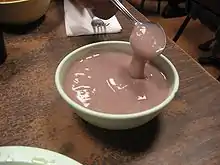Poi (food)
Poi is the primary traditional staple food in the native cuisine of Hawai`i, made from the underground stem (corm) of taro (Hawaiian: kalo).

Traditional poi is produced by mashing the cooked corm (taro root, either baked or steamed) on a papa ku‘i ‘ai, a wooden pounding board, with a pōhaku ku‘i ‘ai, a carved basalt pestle. Modern methods use an industrial food processor to produce large quantities for retail distribution. Freshly pounded taro without the addition of water is called pa‘i ‘ai and is highly starchy and dough-like. Water is added to the pa‘i ‘ai during mashing, and again just before eating, to achieve the desired consistency, which can range from highly viscous to liquid. As such, poi can be classified as "one-finger", "two-finger", or "three-finger" depending on the consistency, alluding to how many fingers are required to scoop it up (the thicker the poi, the fewer fingers required to scoop a sufficient mouthful).[1]
Poi can be eaten immediately, when fresh and sweet, or left a bit longer to ferment and become sourer – it then develops a smell reminiscent of plain yoghurt. A layer of water on top can prevent fermenting poi from developing a crust.
History and culture
_(14591199899).jpg.webp)

Taro, a root vegetable thought to be native to Southern India and Southeast Asia and the primary poi ingredient, was highly regarded by Hawaiians, who believed that the taro plant (kalo) was the original ancestor of the Hawaiian people. Poi was considered such an important and sacred aspect of daily Hawaiian life that Hawaiians believed that the spirit of Hāloa, the legendary ancestor of the Hawaiian people, was present when a bowl of poi was uncovered for consumption at the family dinner table. Accordingly, all conflict among family members was required to come to an immediate halt.[2]
Although many of the world's people consume taro, only Hawaiians make poi. Hawaiians traditionally cook the starchy, potato-like heart of the taro corm for hours in an underground oven called an imu, which is also used to cook other types of food such as pork, carrots, and sweet potatoes.[3]
In recent years, taro-production shortages (from pests and labor shortages) have led to higher prices for poi in Hawaiʻi. But at the same time, innovations in poi production have resulted in new formulations of poi that stay fresh longer and taste sweeter. However, such products generally sell at a premium price and require refrigeration, unlike traditional poi which can be kept unrefrigerated as it naturally ferments instead of spoiling.
Fermentation
Poi has a paste-like texture and a delicate flavor when freshly prepared in the traditional manner, with a pale purple color that naturally comes from the taro corm. It has a smooth, creamy texture. The flavor changes distinctly once the poi has been made: fresh poi is sweet and edible; each day thereafter the poi loses sweetness and turns sour due to a natural fermentation that involves lactobacillus bacteria, yeast, and Geotrichum fungi.[4] Therefore, some people find fermented poi more palatable if it is mixed with milk or sugar or both. The speed of this fermentation process depends upon the bacteria level present in the poi,[5] but the souring process can be slowed by storing poi in a cool, dark location. To prepare commercial poi that has been stored in a refrigerator, it is squeezed out of the bag into a bowl (sometimes adding water), and a thin layer of water is put over the part exposed to air to keep a crust from forming on top. New commercial preparations of poi require refrigeration, but stay fresh longer and taste sweeter.
Sour poi is still edible but may be less palatable, and is usually served with salted fish or Hawaiian lomi salmon on the side (as in the lyrics "my fish and poi"). Sourness can be prevented by freezing or dehydrating fresh poi, although the resulting poi after defrosting or rehydrating tends to taste bland when compared to the fresh product. Sour poi has an additional use as a cooking ingredient with a sour flavor (similar to buttermilk), usually in breads and rolls.
Nutrition and dietary and medical uses
Taro is low in fat, high in vitamin A, and abounds in complex carbohydrates.[6]
Poi has been used specifically as a milk substitute for babies, or as a baby food.[7] It is supposed to be easy to digest. It contains no gluten, making it safe to eat for people who have celiac disease or a gluten intolerance.[7]
See also
- List of ancient dishes and foods
- Ube halaya – Philippine dessert made from purple yam
- Nilupak – Filipino delicacies made from mashed starchy foods
- Fufu – West African dish made from mashed cassava
Notes
- Robert Trumbull,"In Hawaii, Poi is the Staff of Life", "The New York Times", 31 Oct. 1982
- GRAIN | Seedling | 2006 | Haloa
- "What Is Poi Anyway?", Retrieved on November 13, 2012.
- McGee, Harold. On Food and Cooking. Scriber, 2004. ISBN 978-0684800011, pg. 295
- Brown, AC; Valiere, A (2004). "The medicinal uses of poi". Nutr Clin Care. 7 (2): 69–74. PMC 1482315. PMID 15481740.
- "Powered By Poi" Archived 2011-10-08 at the Wayback Machine Maui No Ka 'Oi Magazine Vol.11 No.4 (July 2007)
- Brown, AC; Valiere, A. "The medicinal uses of poi". Nutr Clin Care. 7: 69–74. PMC 1482315. PMID 15481740.
References
- Craig W. Walsh, Where Can I Buy Poi?, POI, 26 May 2005. Retrieved on 12 November 2012.
- Amy C. Brown and Ana Valiere, The Medicinal Uses of Poi, The National Center for Biotechnology Information, 23 June 2006. Retrieved on 13 November 2012.
- Sky Barnhart, Powered by Poi Kalo, a Legendary Plant, Has Deep Roots in Hawaiian Culture, NO KA 'OI Maui Magazine, July/August 2007. Retrieved on 13 November 2012.
- Marcia Z. Mager, What Is Poi Anyway?, POI, 24 March 2009. Retrieved on 11 November 2012.
- Stacy Yuen Hernandez, Got Poi? The Original Hawaiian Diet, POI, 24 March 2009. Retrieved on 11 November 2012.
- Pamela Noeau Day, Poi – The Ancient Superfood, POI, 22 December 2009. Retrieved on 11 November 2012.
External links
| Wikimedia Commons has media related to Poi (food). |
- The History of Poi
- "Powered By Poi" Maui No Ka 'Oi Magazine Vol.11 No.4 (July 2007).
- "Kipahulu Kitchen" Article about community commercial kitchen in Kipahulu, Maui, where poi is made. Maui No Ka 'Oi Magazine Vol.10 No.2 (April 2006).
- "Poi" YouTube video about the making of Poi.
